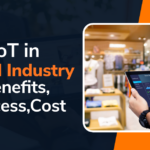Table of Contents
Introduction
Hardly any industry is untouched by the massive effect of digital transformation. Among the most disruptive innovations characterized with versatile use across fields is the Internet of Things or IoT. It connects physical objects or items to the web. However, due to the popular ideation of IoT being primarily consumer-focused- meaning powering smart homes and similar types of gadgets and devices, we have certainly failed to understand that the most significant impact may be actually in the commonly called Industrial Internet of Things or IIoT.
Most of the manufacturing innovators are currently working to allow the equipment and machines to communicate by means of gathering, receiving as well as distributing information. With the arrival of cheap and compact sensors along with high-bandwidth wireless networks, it has become way much easier. Now, companies can easily leverage the powerful analytical systems in the workflows and also utilize real-time data to enhance the overall quality of the products significantly, while constantly decreasing costs.
Within a few years, it is expected that most of the main new business processes, as well as systems, will incorporate certain kinds of IoT elements developed by any IoT development company. In the manufacturing industry, executives are more likely to spend billions of dollars on the technology, which demonstrates the extent of the entire role which IoT will certainly play in various industrial processes. Also, IoT has the inherent power to cut across different aspects of manufacturing while completely streamlining the different processes. It will blur the boundaries between various factory operations, product design and demand management, supply chain and enable virtual tracking of processes, assets, resources, and products.
Now, let’s have a detailed discussion on how IoT will revolutionize and then become the foundation of manufacturing:

1. Improved Supply Chain Management
With the assistance of IoT, supply chain management actually becomes more data-driven. Also, asset tracking can easily be improved with new GPS and RFID sensors which can track the products right from the floor to the store.
At any instant, manufacturers can utilize these sensors in order to access granular data which includes storage conditions, temperature, the time spent by an item in cargo, how long it took to actually fly off the shelf. This particular type of data gathered from an IoT network assists the companies in getting a better hold on quality control, product forecasting, and on-time deliveries.
This can certainly improve vendor relations too. The entire partnership ecosystem is completely enriched by data which ensures that all of the concerned parties have complete access to the information pertaining to the product and it allows manufacturers to create an additional layer of transparency into various processes and also communicate with suppliers as well as vendors in a much more effective way. Along with this, it is also possible to easily recognize sub-par vendor terms which may be costing money to the manufacturer.
Better and improved management also permeates inventory and forecasting. IoT sensors, along with analytics, can easily suggest the best inventory optimization in a highly accurate way.
Along with this, by offering constant visibility into the company supplies left in the stock, future planning is built on the exact foundations. It allows for the creation of more stable and predictable manufacturing schedules. For instance, the technology completely oversees that materials or products are never expired, damaged or out of stock.
Logistics structures are also fortified. By enabling the creation of a fully interconnected, dynamic fleet, all of the company carriers are linked. Operators can consistently safeguard different transportation processes, and even locate problematic channels as well as leverage the functional ones.
Also, by receiving information regarding the physical state of every transportation unit like consumption, geolocation, maintenance record, delays or weather, they can easily develop robust risk management contingencies and even avert any type of potentially unpleasant occurrence in quite an effective way.
Related Blog: Internet of Things: A game-changer in the education industry
2. Enhanced Workers’ Safety
One of the crucial benefits of IoT is that it can easily assist in preventing dangerous workplace situations. There are companies that are developing different industrial IoT setups that protect the workers through the use of predictive analysis. Systems like these can easily be utilized, for instance, to avert a collision or even analyze the body movements of the workers in order to make sure that procedures are carried out in quite an efficient way. Wherever dangerous situations are detected, the machines can easily be disabled, or even other interventions can easily be made.
Another crucial benefit of IoT is that it also allows for interaction with an item or an object without any actual physical interference. As the workers don’t have to touch the machines to use them necessarily, their overall safety is improved by a significant margin.
For instance, companies can easily deploy collaborative robots that can handle various dangerous tasks that would otherwise pose a major safety risk to the workers.
Worker safety remains to be of utmost importance as occupational injuries can be quite costly, both in financial and human costs.
With the installation of IoT in place, an environment which indicates an intense humidity, dangerous pressure condition, excessive noise as well as higher temperature levels or even the presence of different dangerous substances, is immediately reported to the responsible operators, which contributes to the overall eradication of the most common types of workplace hazards.
Similarly, we are more likely to see various connected wearable devices to become a worker’s attire’s integrated part gradually. They certainly have an indispensable role in order to prevent injuries and other types of tragedies as they can easily monitor individual health as well as risk activities. Their functionalities can be quite an industry-specific. For instance, location trackers have often been proven as particularly valuable in sectors like mining.
Similarly, there are various complex sensors as well as algorithms that can reveal alarming signs of approaching microsleeps in the factory workers or even smart helmets which can transmit the state of the worker as well as data concerning their surroundings.
3. Seamless and Streamlined Maintenance
Providing devices with the inherent ability to easily transmit real-time data actually allows for better oversight over the entire production process. Each machine can easily be monitored and even controlled remotely, with various guiding protocols set-up in a particular way to ensure the usage to be most effective.
This essentially means that manufacturers are provided with different diverse choices- from limiting the entire energy usage to even watching out for any type of potential breakdown. For instance, few companies are claiming that they have the inherent capacity to reduce unplanned downtime by a significant margin easily.
Moreover, leveraging sophisticated technical data packages can enhance how manufacturers manage and utilize the detailed data collected from IoT devices. These packages help organize and present data effectively, ensuring that all machine-related information is accessible and actionable. This is critical for executing maintenance strategies that rely on IoT-generated insights, thereby extending the lifecycle of machinery and minimizing disruptions in manufacturing processes.
Shifting from reactive to predictive maintenance, various smart sensors that are attached to the industrial machine can easily analyze environmental aspects, that include temperature, sound frequency, and vibrations. The corresponding and related condition-based alerts make sure that potential threats are successfully mitigated even before they actually arise, which prolongs the machine life cycle as well as remove any types of unwanted disruptions to the manufacturing or production. Not only does the IoT helps in reducing machine downtime, but it also transforms the traditional preconceptions radically regarding the overall facility management.
Normally, check-ups can be extremely time-consuming, but IoT makes them quite simpler than ever. The never-ending manual maintenance cycle is broken which means engineers can now receive notifications on their own smart devices, which summarizes all of the required information regarding the issue and even guide them to where their attention is required.
Workers can easily utilize a wide range of wearable devices in order to support maintenance tasks, For instance, there are companies which develop smart wearable equipment that includes helmets and glasses, and they utilize Augmented Reality technology in order to allow the workers to easily work alongside any remote expert in order to deal with a particular specialist maintenance task.
Related Blog: Tips to Transform Industrial Workflow with Artificial Intelligence
4. Controlled and Regulated Production Flow Management
A major characteristic of IoT is the high degree of interrelation, which enables the manufacturers to easily monitor their production line right from the refining process to all the way to shipping. The huge volume of data can easily help the companies to actually understand their different business processes in a better manner and indicate how to optimize operations in more further completely.
Also, the manufacturers have better tools in order to keep a finger on the pulse of the entire production processes, even in high-level and fast-paced settings.
In case a machine breaks or underperforming, the production flow can easily be effortlessly and immediately reconfigured in order to maintain efficiency. IoT solutions can easily analyze the present state of things and even find the most effective and best-suited solution.
Similarly, sensors can easily be utilized in order to measure benchmarks that determine the performance as well as the durability of the products way before their distribution. However, we know that quality control is rapidly becoming a cornerstone isn’t just the only benefit. With the assistance of an analytical lens, the manufacturers can easily compare their projected operation goals with the actually achieved results, optimize them wherever it is required and even synchronize production with various available resources as well as priorities of the business.
The cross-channel visibility, which is introduced by IoT, also provides mass customization. By becoming a great source of real-time data that is required for shop floor scheduling, forecasting, and routing, the businesses can easily create their products that fit the exact requirements of a particular purchase, along with retaining high production volumes. This essentially means that industrial IoT provides a cost-effective and efficient mass production of customized products.
Just like other digital technologies are applied in manufacturing, IoT strives to do more with less ultimately. Not only does this particular technology assist in optimizing specific processes, but its extensive and nearly universal applicability also earns it a significant and unique position of being a vital and compulsory tool for more transparent and integrated manufacturing schemes.
5. Enhanced Energy Efficiency
Energy usage can certainly be one of the greatest expenses of a company, and mostly, the companies are overpaying for it. It is due to the fact that the energy bill doesn’t actually break down various areas of energy consumption to actually allow the companies to find where the inefficiencies may lie. In this regard, IoT allows you to track each piece of equipment along with its performance, highlighting abnormal consumption patterns as well as efficiency gaps while also pinpointing different areas of improvement. With the increasing tightened environmental regulations, the inherent ability to improve the company’s energy efficiency becomes much more valuable.
6. Improved Product Quality
Maintaining product quality is quite critical for all of the manufactures, especially in the case of small as well as medium-sized companies that strive to grow their business. One particular factor, which is a major contributor to poor quality products is the equipment itself. Incorrectly calibrated, aligned or maintained equipment can easily result in defective and deformed products, and this can seriously have far-reaching effects like loss of customer trust, pricey product recalls, loss of customers and worst, loss of life.
IoT can easily make a substantial difference in product quality management. For instance, the sensors can promptly alert the staff whenever there is a major production issue so it can easily be taken care of before any waste occurs and any particular issues can easily be addressed before the manufactured product actually leaves the factory floor.
Conclusion
Companies from different industry verticals have witnessed substantial digital transformation. For technologies like Artificial Intelligence and Machine Learning, Augmented Reality and Virtual Reality, the companies are adopting them to improve their business processes and operations. However, IoT or Internet of Things is one of the most popular and widely adopted technologies which has revolutionized multiple industries. In the case of the manufacturing industry, it has brought significant bandwidth wireless networks, and it has become easier for the manufacturing companies to leverage the benefits of IoT. It allows the companies to gather real-time data in order to improve the quality of the products, decrease costs and enhance the efficiency of the processes.
IoT makes supply chain management data-driven in manufacturing companies. Manufactures can keep an eye on various industrial data like temperature, storage conditions, time spent by the product in cargo, etc. It assists in improving quality control, on-time deliveries and product forecasting. It also helps in improving vendor relationships. IoT can improve company management. It improves logistics structures and helps in keeping a close look at the fleet that becomes interconnected due to the utilization of IoT technology. It helps in maintaining consumption, maintenance record, geolocation and other vital aspects of the fleet.
IoT is now allowing the manufacturers to reduce the risk faced by their workers. It increases the safety of the workers by monitoring machines. Predictive analysis aided by IoT allows the companies to avert collision and avoid machine-related mishaps. IoT allows the companies to deploy collaborative robots that can easily handle the most dangerous tasks and keep the workers from harm’s way. It can keep a check on various factory data like dangerous pressure conditions, intense humidity, excessive noise, etc. and avoid risky encounters of the workers to such conditions.
IoT enables the companies to monitor and remotely control the machines by using guiding protocols that improve their efficiency. It helps in preventing the breakdown of machinery and avoid loss of money through interrupted production. IoT offers predictive maintenance with the deployment of sensors that are attached to machines. These sensors can provide analysis of various environmental aspects which consist of sound frequency, temperature, and vibrations. It can issue condition-based alerts in order to ensure that potential threats are mitigated in proper fashion. IoT helps in reducing the overall downtime of machines.
IoT helps the manufacturing companies to monitor their entire production line easily. The huge volume of data gathered allows the companies to understand the business processes in a better and comprehensive manner which helps in optimizing the operations further. IoT sensors can be used to measure the benchmarks that determine the durability as well as the performance of the products before they are sent for distribution. It also helps with quality control. Industrial IoT offers efficient and cost-effective mass production of various customized products.
IoT is revolutionizing the manufacturing industry in a significant way. With the development of smart sensors, better connectivity, and improved algorithms, IoT helps in improving the efficiency and effectiveness of various business processes and operations of manufacturing companies. IoT allows these companies to reduce the cost of production, helps in mitigating risk to the workers and even avoids machinery breakdowns. It improves and streamlines logistics. With better fleet management of companies’ vehicles, it reduces the cost of delivery of the products and avoids wastage of resources and time.
In the near future, we will see different technologies like Augmented Reality and Virtual Reality to be applied in the development of IoT apps and solutions. We will witness the introduction of artificial intelligence and machine learning that will considerably improve the efficiency of the business processes. Using these technologies and data-driven analytics, the company owners will be able to make many better-informed decisions. It will aid them to have a complete overview of the manufacturing processes and their related data. This will improve their decision-making by a significant margin. Hence, IoT will not only revolutionize the manufacturing industry but even become its foundation in the times to come.

























